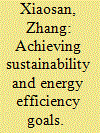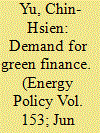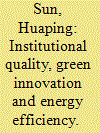|
|
|
Sort Order |
|
|
|
Items / Page
|
|
|
|
|
|
|
| Srl | Item |
| 1 |
ID:
180143


|
|
|
|
|
| Summary/Abstract |
This study examines the relationship between total renewable electricity generation, total hydroelectric generation, and carbon dioxide emissions (CO2e) for China. The autoregressive distributed lag (ARDL) model showed that renewable electricity generation, hydroelectric generation, and green innovation decreased CO2e in China from 1990 to 2018, whereas gross domestic product per capita and foreign direct investment increased CO2e. Moreover, the Granger-causality test results are as follows. First, a two-way causal flow from CO2e to foreign direct investment and CO2e to gross domestic product per capita confirmed the feedback hypothesis. Second, a one-way causal flow from hydroelectric and renewable electricity generation to gross domestic product per capita supported the energy-led growth hypothesis. Third, the causality test reflected a one-way causal flow from renewable electricity generation to foreign direct investment and hydroelectric generation to foreign direct investment and renewable electricity generation. This study asserts the need for government to introduce taxes and other incentives for solar, wind, and hydropower-related projects. The paper also calls for designing policies to improve the market attractiveness of hydroelectric generation projects through special investment programs.
|
|
|
|
|
|
|
|
|
|
|
|
|
|
|
|
| 2 |
ID:
178842


|
|
|
|
|
| Summary/Abstract |
This paper investigates the effects of financing constraints on prompting green innovations using a sample of Chinese listed firms in the period 2001–2017. Also, we explore how green finance policies resolve financing constraints of firms to green innovation. The capability of green innovation is found to be impaired when firms face higher financing constraints, and privately owned enterprises tend to be more vulnerable than state-owned ones in this regard. Although green finance policies can effectively ease financing restraints on green innovation overall, green credits are less likely to be available to privately owned enterprises. However, these enterprises which are deeply affected by financing constraints have relatively high innovation capabilities. We suggest the government to provide more supports to privately owned enterprises for investing in green projects. Further, both financial institutions and privately owned enterprises should be required to disclose more information on green credits and green projects, respectively. In addition, the China Banking Regulatory Commission should design a synthetic mechanism for evaluating green performance.
|
|
|
|
|
|
|
|
|
|
|
|
|
|
|
|
| 3 |
ID:
187916


|
|
|
|
|
| Summary/Abstract |
This paper applies data of listed Chinese companies from 2000 to 2017 and a time-varying DID model to examine the effect of the National Development Zones (NDZs) and Provincial Development Zones (PDZs) on green innovation. First, it is found that NDZs can significantly boost companies' green-innovation, while PDZs can slightly inhibit the quality of green innovation. These results still apply even after a series of robustness checks. Second, supply chain finance, environmental regulation, and green finance are three mechanisms through which NDZs exert a beneficial influence on green innovation. In contrast, the negative effects of PDZs stem primarily from lax environmental regulations. Finally, heterogeneity analysis shows that the establishment of NDZs has a significant effect on promoting green innovation in non-resource-based urban enterprises, non-state-owned enterprises, and small-scale enterprises.
|
|
|
|
|
|
|
|
|
|
|
|
|
|
|
|
| 4 |
ID:
186213


|
|
|
|
|
| Summary/Abstract |
Based on the geographic coordinates of bank branches and firms, this study analyzes the impact of firm-level bank competition on corporate green innovation and its underlying mechanisms. The findings of this study are mainly as follows. First, bank competition promotes corporate green innovation by reducing transaction costs, increasing the possibility and quantity of firms applying for green patents. Second, bank competition increases the share of green innovation while reducing the share of nongreen innovation. Third, environmental regulation strengthens the promotion effect of bank competition on corporate green innovation, and the strengthening effect is greatest when environmental regulation is between its 50th and 75th quantile. The proportion of state-owned banks weakens the promotion effect of bank competition on corporate green innovation. This paper is helpful to understand the impact of the banking system on sustainable economic development.
|
|
|
|
|
|
|
|
|
|
|
|
|
|
|
|
| 5 |
ID:
179725


|
|
|
|
|
| Summary/Abstract |
This paper takes China's pilot emission trading policy as a quasi-natural experiment to study the green innovation effect. Based on the green patent data of listed companies in China from 2000 to 2018, the spatial Durbin model was used to explain the green innovation effect of the emission trading policy on pilot areas and neighboring areas at the national level, and the heterogeneity was further discussed according to the patent types in this paper. Further, the interaction effect of the policy and government intervention was studied in this paper. The conclusions can be obtained as follows: First, the emission trading policy has a significant promotion effect on the green innovation in the pilot areas, and a significant inhibitory effect in the neighboring areas. Second, there is a patent type heterogeneity between the green invention innovation effect and the green utility model innovation effect. The emission trading policy only shows a significant spatial spillover effect in green utility model innovation. Third, a high level of government intervention will inhibit the green innovation effect. This article provides empirical evidence and policy implementations to better promote the green innovation by implementing the emission trading policy more rationally.
|
|
|
|
|
|
|
|
|
|
|
|
|
|
|
|
| 6 |
ID:
169866


|
|
|
|
|
| Summary/Abstract |
This paper examines the energy efficiency performance of a sample of 71 developed and developing countries between 1990 and 2014. In most current energy literature, the transition to green technology is seen as a sustainable way to achieve a low-carbon or carbon-free environment. Bearing this in mind, we argue further that adopting green technology needs a strong backing and funding of reliable government institutions to shift the country's paradigm. Considering this issue, we adopt the parametric stochastic frontier approach built on the shepherd distance function to evaluate the effects of both governmental institutions and green technologies on energy efficiency. We find evidence of a significant positive influence of both green innovation and institutional quality on energy efficiency enhancement having controlled for some variables. Regarding energy efficiency levels of the individual countries- USA, Japan, Germany and Australia lead the chart while Belize, Panama, Singapore, Malta, Sierra Leone, Iceland, Jamaica, Bahrain and Ghana are the least energy efficient countries. Policy implications are further discussed.
|
|
|
|
|
|
|
|
|
|
|
|
|
|
|
|
| 7 |
ID:
187607


|
|
|
|
|
| Summary/Abstract |
China launched seven pilot areas for climate change mitigation before establishing a unified carbon emissions trading system in 2014. To explore the heterogeneous effect of carbon trading regulation on green innovation in China, we constructed evolutionary games with players of governments and enterprises. We then conducted empirical studies with the difference-in-difference model. With the data of listed Chinese A-share companies from 2008 to 2018, we found that implementing carbon trading pilot projects in China significantly increases the green innovation output of enterprises in the pilot regions. Additionally, the sensitivity to carbon trading policies varies across industries and property rights. Regarding the quality of green innovation triggered by the pilot project, firms in the pilot regions prefer high-quality green invention patent innovations over low-quality green utility model patent innovations. In addition, state-owned enterprises tend to apply for high-quality green invention patents, while firms in high-pollution industries prefer to apply for lower-quality green utility model patents. Finally, we put forward policy suggestions. First, China should accelerate the pilot carbon trading regulation and expand its scope. Second, there should be regional and industrial differences in constricting carbon trading regulations. Third, the government should avoid unreasonable regulatory intensity design.
|
|
|
|
|
|
|
|
|
|
|
|
|
|
|
|
|
|
|
|
|